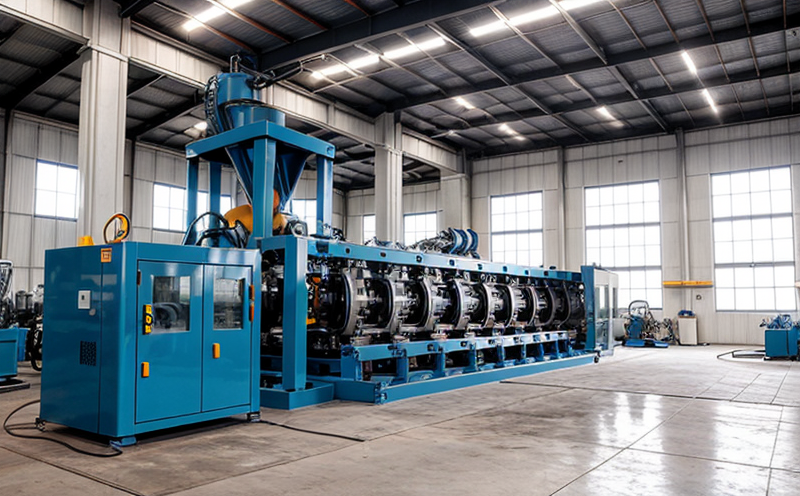ASTM F1147 Adhesive Joint Performance Testing in Machinery
In industrial manufacturing and processing, machinery reliability is paramount. One of the key aspects ensuring this reliability lies in the integrity of adhesively bonded joints within complex machinery systems. ASTM F1147 is a standardized method that evaluates the performance of these adhesive bonds under various stress conditions to ensure they meet quality specifications.
The test assesses shear strength and durability, which are critical for the longevity and safety of equipment used in manufacturing processes. This standard is particularly relevant when dealing with high-stress environments where machinery might experience continuous load cycles or sudden impacts. By adhering to ASTM F1147, manufacturers can ensure that their products meet stringent quality control measures set by industry standards.
The methodology involves applying a defined shear force on the adhesive joint between two substrates while monitoring displacement and stress distribution using high-precision instruments such as universal testing machines equipped with appropriate fixtures. The test conditions are designed to simulate real-world operational stresses, providing valuable insights into how well the bonded components will perform under actual use.
This service is essential for quality managers, compliance officers, R&D engineers, and procurement teams looking to verify product performance against industry benchmarks. It helps in identifying potential weaknesses early in the development phase or during ongoing production processes, thereby reducing costly failures later on.
The ASTM F1147 test plays a crucial role not only in ensuring that adhesives used in machinery meet specific requirements but also in enhancing overall equipment reliability. By adhering to this standard, manufacturers can build trust with their customers and demonstrate commitment to excellence in product design and manufacturing.
For instance, aerospace companies rely heavily on adhesive joints for critical components like landing gear, while automotive manufacturers use them extensively for structural reinforcements within vehicles. In both cases, ensuring that these bonds are robust enough to withstand high loads is essential for safety and performance.
The ASTM F1147 test provides a reliable way to measure this strength, offering peace of mind to those responsible for selecting materials and processes. With its focus on shear resistance and durability, it ensures that the joints in question can handle the demands placed upon them without compromising structural integrity or operational efficiency.
Moreover, this testing aligns with broader quality assurance initiatives aimed at improving product reliability across industries. By incorporating ASTM F1147 into their workflows, manufacturers demonstrate their commitment to excellence and compliance with international standards.
Scope and Methodology
| Parameter | Description |
|---|---|
| Test Specimens | Axially symmetric specimens fabricated from the materials intended for bonding. |
| Adhesive Bonding | An adhesive is applied between two substrates and cured according to specified conditions. |
| Shear Testing | Standardized shear forces are applied using a universal testing machine until failure occurs. |
| Data Collection | Displacement, strain, and stress values are recorded during the test. |
The ASTM F1147 test focuses on evaluating the shear strength of adhesive bonds in machinery components. This involves preparing specimens made from materials that will be joined using adhesives. Once bonded, these specimens undergo a series of tests designed to simulate the stresses they would encounter during normal operation.
During the testing process, a precise amount of shear force is applied to the bond line until failure occurs. The displacement and strain experienced by the specimen are continuously monitored throughout this procedure. These measurements provide valuable data about the performance characteristics of the adhesive used in these joints.
The results from ASTM F1147 tests can help determine whether an adhesive meets the necessary requirements for use within specific applications. For example, if a particular joint is expected to experience significant shear forces during its lifecycle, it's important to ensure that the adhesive has sufficient strength and durability to withstand these conditions.
By adhering closely to ASTM F1147 guidelines when performing these tests, manufacturers can gain confidence in their choice of adhesives for bonding machinery components. This not only enhances product reliability but also supports broader quality assurance efforts aimed at improving overall manufacturing processes.
Benefits
The ASTM F1147 adhesive joint performance test offers numerous benefits to manufacturers operating in the industrial sector, particularly those involved with machinery and equipment design. Firstly, it provides a standardized approach for evaluating the shear strength of adhesives used in bonding processes.
Ensures consistent quality across batches
Identifies potential issues early on
Supports regulatory compliance
Improves product reliability and durability
Saves costs by preventing failures in the field
Promotes trust among stakeholders
By ensuring consistent quality, manufacturers can be confident that their products meet strict industry standards. Early identification of potential issues allows for timely interventions to prevent costly rework or recalls.
In addition to supporting regulatory compliance, this testing process helps promote trust among various stakeholders involved in the supply chain. This includes customers who rely on reliable machinery performance and partners who seek assurance about product quality.
Why Choose This Test
Provides a standardized method for evaluating shear strength of adhesives
Suitable for various types of substrates and adhesives combinations
Involves detailed monitoring of displacement, strain, and stress during the test process
Aids in identifying potential weaknesses early on before they lead to failures in service conditions
Supports regulatory compliance requirements for product safety and performance standards
Promotes reliability and durability of machinery components through rigorous testing procedures
The ASTM F1147 test offers several advantages over other forms of evaluation. It provides a standardized approach that can be applied to different types of substrates and adhesive combinations, making it versatile for various manufacturing environments.
During the testing process, detailed monitoring of displacement, strain, and stress ensures accurate measurement of performance characteristics. This level of scrutiny helps identify any potential weaknesses in the bond before they become critical issues during actual use conditions.
Incorporating ASTM F1147 into your quality assurance protocols can also help meet regulatory requirements related to product safety and performance standards. By demonstrating adherence to recognized international standards, manufacturers enhance their reputation for producing reliable products.





